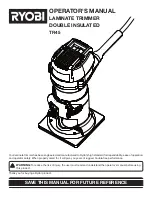
7
TRIMMING
1. Make sure that the work area is free of rock, debris, lines and other foreign objects.
2. Start the tool before approaching the grass to be cut.
3. If you need to release the line, please“bump”the spool button of the trimmer on the ground to
feed outwore line. If too much line is fed out and it projects beyond the guard edge it is cut by the
line cutting blade.
4. Cut the grass by swinging the tool from right to left and proceed slowly keeping the trimmer
inclined forwards at an angle of about 30.Light cuts are better than heavy cuts as they allow the cut
grass to fall away from the spool preventing the grass from clogging the spool.
5. Start cutting nearest the mains power source and work away from it to make it easier to
avoid the cable.
6. High grass should be cut in layers always beginning from the top. Do not cut damp or wet
grass. Do not overload your tool.
7. Avoid wearing the line out quickly by knocking against hard objects (stones, walls, fences, etc).
8. Watch out for kickbacks in the events of impact with hard objects.
9. After finishing the cutting operation, keep the head close to ground level, release the switch
and follow the motor to come to a complete stand still. Place the trimmer on the ground, switch off
and remove the cable plug from the mains supply.
NOTE:
Periodically clean out the grass between the spool and the rim of the guard to prevent the
tool from vibrating.
6. MAINTENANCE
Store the tool, instruction manual and accessories in a secure, dry place. In this way you will
always have the information ready to hand.
1. Remove dust and dirt regularly.
2. Re-lubricate all moving parts at regular intervals.
3. Never use caustic agents to clean plastic parts.
4. Never disassemble the tool or carry out any repairs. Always have the trimmer maintained or
repaired by a competent person at an authorized service center.
5. Replacing the spool.
Inner cover
Spool slots
Spool hole
Fig 6






























